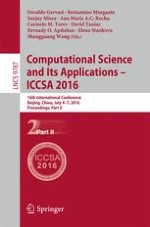2016 | Buch | 1. Auflage
Computational Science and Its Applications – ICCSA 2016
16th International Conference, Beijing, China, July 4-7, 2016, Proceedings, Part II
herausgegeben von: Osvaldo Gervasi, Beniamino Murgante, Sanjay Misra, Ana Maria A.C. Rocha, Carmelo M. Torre, David Taniar, Bernady O. Apduhan, Elena Stankova, Shangguang Wang
Verlag: Springer International Publishing
Buchreihe : Lecture Notes in Computer Science
